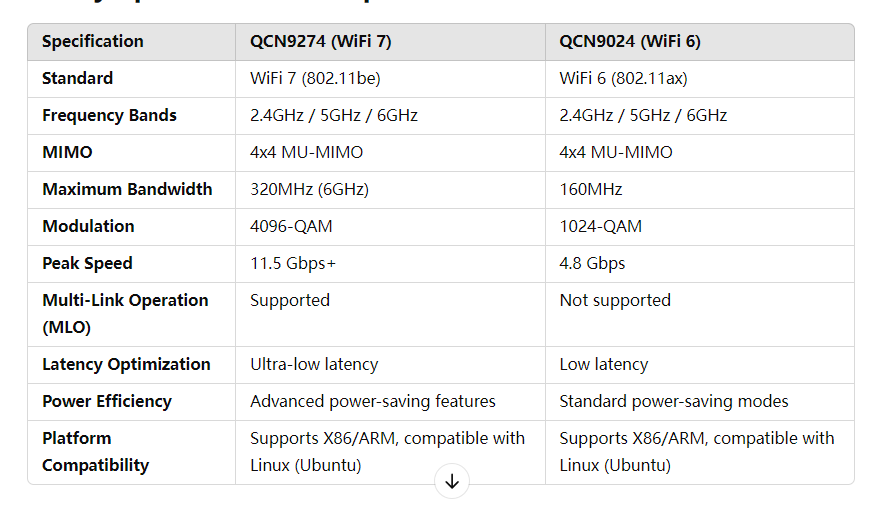WiFi 7 vs. WiFi 6: A Comprehensive Comparison of QCN9274 and QCN9024 for Next-Generation Wireless Networks
As wireless technology continues to evolve, WiFi 7 (IEEE 802.11be) is emerging as the core of next-generation high-performance networking, while WiFi 6 (IEEE 802.11ax) remains a mainstream, efficient solution. In the field of wireless network cards, Qualcomm’s QCN9274 (WiFi 7) and QCN9024 (WiFi 6 Tri-band) are two highly regarded products, both of which support Ubuntu and X86 platforms. However, there are significant differences between them in terms of technology, performance, and applications.
This article provides an in-depth analysis of these two wireless network cards, helping businesses and developers choose the most suitable solution.
1. Core Specifications Comparison

2. Key Technological Advantages
1. Revolutionary WiFi 7 Upgrades (QCN9274)
(1) 320MHz Ultra-Wide Bandwidth for Higher Speeds
QCN9274 supports 320MHz channel bandwidth (on the 6GHz band), doubling the bandwidth of QCN9024’s 160MHz, making it ideal for high-throughput enterprise wireless communications.
(2) 4096-QAM for More Efficient Data Transmission
WiFi 7 introduces 4096-QAM, increasing data transmission efficiency by 20% compared to WiFi 6’s 1024-QAM. This is especially beneficial for high-definition video streaming, VR/AR applications, and cloud gaming.
(3) Multi-Link Operation (MLO) for Enhanced Stability
MLO technology enables QCN9274 to transmit data simultaneously across multiple frequency bands, providing:
Lower latency: Data can be sent over multiple bands at once, reducing congestion.
More stable connections: If one frequency band experiences interference, the device can seamlessly switch to another without disrupting the connection.
(4) Advanced Power Efficiency for Longer Device Lifespan
QCN9274 incorporates Target Wake Time (TWT) optimization, reducing power consumption, making it ideal for IoT, industrial automation, and smart city applications.
2. The Stability and Reliability of WiFi 6 Tri-Band (QCN9024)
(1) Tri-Band Concurrency for Optimal Performance
QCN9024 supports 2.4GHz, 5GHz, and 6GHz frequencies, allowing simultaneous service for different types of devices:
2.4GHz for long-range, low-speed IoT devices.
5GHz for high-bandwidth applications like HD streaming and gaming.
6GHz for additional capacity, reducing interference and improving throughput.
(2) 160MHz Bandwidth for Enterprise-Grade Performance
Although QCN9024 does not support 320MHz bandwidth, its 160MHz channel width still enables 4.8Gbps speeds, making it ideal for video conferencing, large-scale WiFi coverage, and industrial automation.
https://www.wallystech.com/Network_Card/DR9274-5G6G-wifi7-card-moulde-Qualcomm-QCN9274-M.2-Slot-2x2-5G-2x2-6G-dual-band-Wallys.html
sales@wallystech.com
(3) Broad Compatibility with Various Platforms
QCN9024 performs reliably on X86 and ARM platforms, supporting Ubuntu, OpenWRT, and other Linux distributions. It is well-suited for enterprise routers, wireless bridges, WiFi 6 APs, and IoT gateways.
3. Recommended Use Cases

4. Choosing the Right Wireless Network Card
If your business requires extreme speed, ultra-low latency, and next-generation technologies like MLO and 4096-QAM, then the WiFi 7 QCN9274 is the ideal choice.
If you need a stable and mature WiFi 6 tri-band solution with strong compatibility, low power consumption, and cost-effectiveness, QCN9024 remains a top contender.
Whether you choose QCN9274 (WiFi 7) or QCN9024 (WiFi 6), both Qualcomm network cards provide outstanding wireless performance on Ubuntu and X86 platforms, helping businesses build smarter, more efficient wireless networks.
The future is here—WiFi 7 is leading the next era of wireless networking!

Comments
Post a Comment